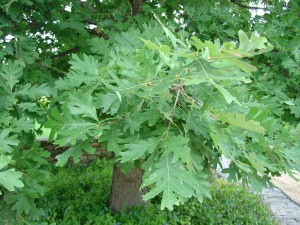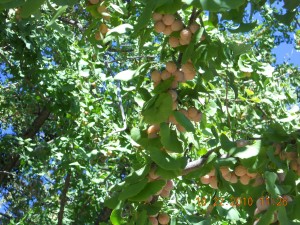Japanese zelkova (Zelkova serrata) is a 60-90 feet tall shade tree with structurally strong branches. Fast growing zelkova may grow 2 feet or more in a single year. Belonging to the elm family (Ulmaceae), zelkova exhibits several elm-like features, including a vase shaped branching habit. Its very different exfoliating mottled bark distinguishes it from elms. […]
Archive for the ‘Large Shade trees’ Category
Promising New American Chestnuts Arriving
Chestnut blight (Diaporthe parasitica Murrill) was first discovered in the Bronx Zoo in 1904. By 1911 the headline in The New York Times read – “All Chestnut Trees Here Are Doomed”. Over the next half century, the pandemic eliminated four billion trees. Today, the airborne bark fungus still persists in the soil and on diseased […]
Sugar Maple Is A Four Star Autumn Attraction
Sugar maple (Acer saccharum) is a native deciduous tree often planted as a large shade or street tree. It commonly grows 60 to 75 feet (and taller) with a dense rounded foliage canopy. Native to central and eastern North America regions, sugar maple grows best in fertile, mildly acidic, moist well-drained soils and in full […]
Pignut Hickory: What’s In A Name
Pignut hickory (Carya glabra) is a medium to large tree that you may fortunately inherit when purchasing property. Pignut deserves a better name like “smooth bark hickory”. The species is commonly found in upland forests. Pignut hickory prefers fertile well-drained soil and in full sun to partial shade. A young seedling trees start off slowly from a large […]
Katsura Tree Comes Home To America
Katsura tree (Cercidophyllum japonicum) is a large 50-60 feet tall tree from Japan and China. Katsura became extinct in North America during the Pleistocene Age and was re-introduced in 1862 by botanist Thomas Hogg. It is truly a beautiful tree, yet is still rarely planted. Katsura is hardy in zones 4-8. It prefers a moist well-drained, compost-rich soil […]
For Lovers and Tree Huggers – American Beech
Mighty as an oak pretty much describes American beech (Fagus grandifolia) as well. Enjoy all four seasons of American beech: spring/summer dark green leaves, dark tan colored fall foliage, long pointed winter buds, and bluish gray bark. It is a large 50-70 foot woodland tree and tolerates incredible amounts of shade. Slow growing beeches are long-lived and best planted on […]
Summer Leaf Drop From Trees
It’s late summer in the Southern Appalachian region (USDA zones 6 and 7). Outdoor temperatures continue to hit 90°F almost daily, and weekly precipitation is low. Over the past 3-4 weeks leaves have been dropping prematurely from landscape trees. Tulip poplar (Liriodendron tulipifera), river birch (Betula nigra), willow (Salix spp.), sycamore (Platanus x acerifolia), […]
No Excuse for Tree Topping
Why do people top trees? Often, it is because “their neighbor(s) did it”. When asked whether they believe their neighbor to be a wise person, the typical response is “NO”. The Negatives About Tree Topping: 1. A topped tree reduces property values in a community. Topping adds a blight look to a neighborhood or over […]
Gather Acorns To Become Mighty Oaks

Several species of oaks (Quercus spp.) make their home here in the Southern Appalachian region (USDA zones 6 and 7). Every 3 – 5 years, a majestic oak bears a heavy crop of acorns. Squirrels and gardeners gather acorns (seeds) to plant oaks for future generations. Oaks are divided into two groups. White, swamp, and bur oaks, with rounded […]

 Posted in
Posted in 

 Tags:
Tags: 
